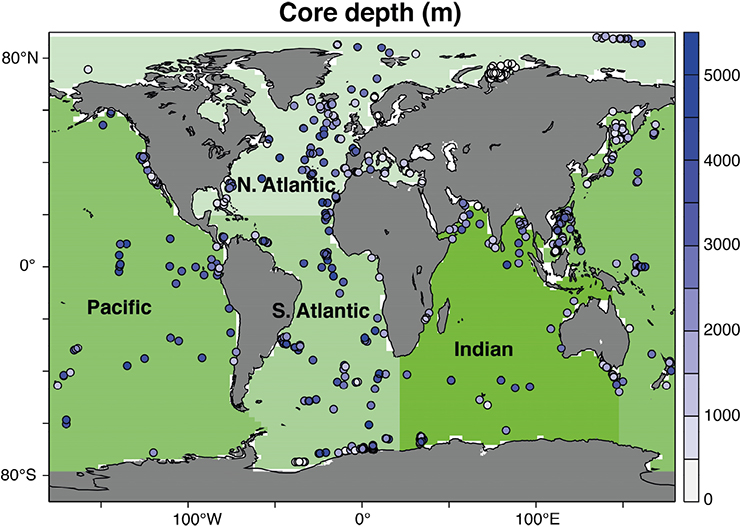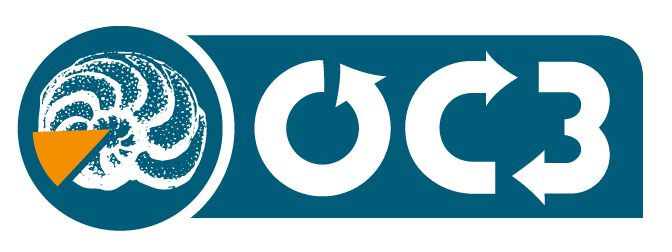- Home
- Publications
- PAGES Magazine
- Regional Carbon Isotope Syntheses From The Last Deglaciation
Regional carbon isotope syntheses from the last deglaciation
Schmittner A, Martínez-Méndez G, Mix AC & Repschläger J
Past Global Changes Magazine
25(3)
154
2017
Andreas Schmittner1, G. Martínez-Méndez2, A.C. Mix1 and J. Repschläger3
Corvallis, USA, 27-29 June 2017
The last deglaciation, which is Earth's climatic transition from the Last Glacial Maximum (LGM, ~21 ka BP) to the Holocene (current interglacial period; ~10 ka BP), is still not fully understood. The associated rise in atmospheric CO2 and related changes in ocean circulation and carbon storage remain puzzling. Carbon isotopes (δ13C) are influenced by ocean circulation and carbon cycling, including the biological pump and air-sea gas exchange, and preserved in the sedimentary record in fossil shells of benthic foraminifera (unicellular organisms living at the sea floor). The PAGES working group Ocean Circulation and Carbon Cycling (OC3) aims to synthesize benthic δ13C sediment data globally to reconstruct and understand the mechanism of natural climate and carbon cycle changes with a focus on the last deglaciation.
 |
|
Figure 1: Map of core locations of the current OC3 down-core database. Also indicated are the regions for which different groups will perform syntheses and data quality control. |
The current, second OC3 phase focuses on down-core data syntheses in different ocean basins (Fig. 1). Goals of this second OC3 workshop were to discuss the progress and first analyses of the data collection, issues of database structure, scientific questions, and possible publications. Talks presented new modeling results on changes in meltwater fluxes during the last deglaciation, and effects of their spatial distribution on ocean circulation. Model results also explored connections between the Atlantic Meridional Overturning Circulation (AMOC), deep ocean carbon storage and isotope distributions, and atmospheric CO2. A presentation on age-model uncertainty showed differences of more than 1,000 years depending on the method used to construct the age model (radiocarbon versus oxygen-isotope alignment versus surface-property alignment). Down-core data from the North Atlantic raised the question of northern versus southern sources for reconstructed, very depleted δ13C and δ18O deep water (Repschläger et al. 2015; Keigwin and Swift 2017), whereas negative δ13C excursions in intermediate waters may be explained by changes in the efficiency of the biological pump (Lacerra et al. 2017).
Presentations on Pacific Ocean syntheses showed that the water-mass geometry in the southeast Pacific did not substantially change during the LGM and suggested larger than previously thought mean-ocean δ13C change during the deglaciation, which may challenge existing interpretations about changes in terrestrial carbon storage. A decoupling of the Pacific from the Atlantic circulation during the LGM was suggested by a comparison of δ13C depth transects from the southwest Pacific and the southwest Atlantic. The single presentation about the Indian Ocean confirmed earlier studies linking changes in AMOC with monsoonal variations during the last deglaciation. The Indian Ocean and cores from intermediate depths are currently underrepresented in OC3. Presentations on ice-core data included updates to age models and highlighted rapid and coeval changes in CH4, CO2 and δ13CCO2, not only during the last deglaciation but also for earlier parts of the last glacial cycle.
LinkedEarth (http://linked.earth; a partner project of PAGES’ 2k Network), a new, searchable, open-source, wiki-like platform for paleoclimate data compilation and curation, was introduced to the participants including a tutorial. Participants agreed to use this platform to publish the final OC3 database product.
Discussions noted differing data quality among sediment cores. Since the objective of OC3 is to include all data, it was recommended that information on data quality, including species used, age models and uncertainties, time resolution, and analytical errors, will need to be reported in the database. All data will be quality checked and flagged by multiple scientists according to their regional expertize. Initial groups for the North Atlantic, the South Atlantic, and the Pacific have already been formed. All groups are open to participation from interested colleagues.
OC3 plans to publish three regional syntheses and one global synthesis paper. The next and final OC3 meeting will be in Cambridge, UK, from 13-16 September 2018, preceded by informal meetings at the AGU Fall and Ocean Sciences meetings.
affiliations
1College of Earth, Ocean, and Atmospheric Sciences, Oregon State University, Corvallis, USA
2MARUM-Center for Marine Environmental Science, University of Bremen, Germany
3Department Climate Geochemistry, Max-Planck Institute for Chemistry, Mainz, Germany
contact
Andreas Schmittner: aschmitt coas.oregonstate.edu
coas.oregonstate.edu
references
Keigwin LD, Swift SA (2017) PNAS 114: 2831-2835
